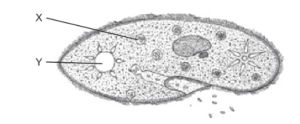3. The salt concentration inside the
Paramecium is 1.8 %. The salt concentration in the surrounding medium suddenly drops to 0.2 %. What will be the likely response?

[Source: Adapted from www.biology-resources.com. Copyright 2004–2017 D G Mackean & Ian Mackean. All rights reserved.]